Energy and biomass in food chains
L.O To understand how energy is transferred from one organism to another. To learn how to interpret food chains and food webs.
Food chains show how energy is transferred from one organism to the next. The food chain starts with a producer usually a plant who can produce its own energy using the light from the sun
The producer is then eaten by the primary consumer, then the secondary consumer and so on.
The arrows in a food chain show in which direction the energy is moving
Producers in this case, the grass can make the energy through the process of photosynthesis. The primary consumer usually only eats plants and can also be referred to as a herbivore
The secondary consumer will eat the primary consumer, so because it eats other animals it can be referred to as a carnivore.
Food webs
Food webs are a series of interconnected food chains, they can be complicated to look at but if you break them down they can be very simple.
An example of a food web can be seen below
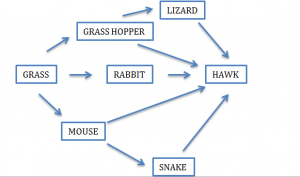
The food web can be split up into five simple food chains
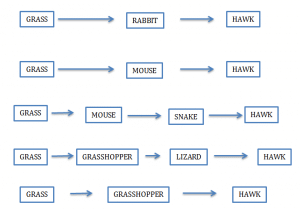
From the food web we can deduce that the grass is the producer.
The mouse, grasshoppers and rabbits are the primary consumer
The snake and lizards are secondary consumer and the hawk is the tertiary consumer (it is also a secondary consumer)
Competition
Food webs also demonstrate he level of competition within organisms. For example the mouse, grasshopper and the rabbit are all competing for the grass, if one organism eats more then there is less for the others.
Animals and plants also compete for water, space and habitats in order to survive
In a food web, changes in a population of certain organisms can impact the rest of the food web. A major example is if the population of grass dramatically decreased, that would mean less food for the primary consumers and thus the population of the primary consumers will decrease and this will affect the secondary consumers and the tertiary consumers also. This process is known as interdependence
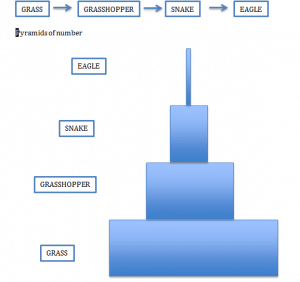
The pyramid of numbers highlights how many organisms are present at each level. Each level is called a trophic level. As we move up each trophic level the energy is lost. Energy is lost to the surroundings in a number of ways. The most common way of energy loss is through movement. As organisms move they consume energy and therefore less is passed on. Also as organisms respire energy is lost to the environment in the form of heat.
The pyramid illustrates how there is a lot of grass and it is eaten by many grasshoppers. There are less snakes but they eat more grasshoppers and the same applies to the eagles.
However all pyramids are not symmetrical and can come in other shapes
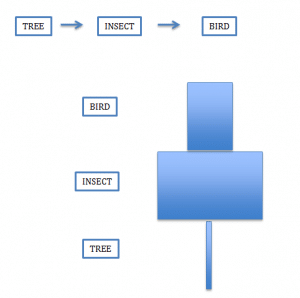
This pyramid highlights how there is only one tree but there are many insects feeding off it. The insect is the primary consumer. The bird is the secondary consumer; there are less birds however they eat more insects.
Pyramids of biomass
Pyramids of biomass highlight how much dry mass there is at each trophic level. The dry mass of an organisms is the mass present when all the water has been removed.
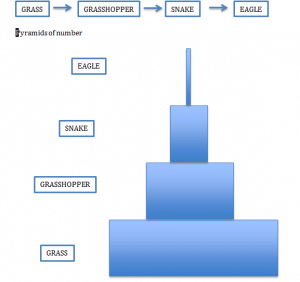
Even in pyramids of biomass energy is lost as you move up each trophic level
Energy is lost in a number of ways:
It is lost as heat energy through movement
In certain animals, energy is used to maintain body temperature
It is also lost in processes such as respiration and photosynthesis
It is also lost in feces


